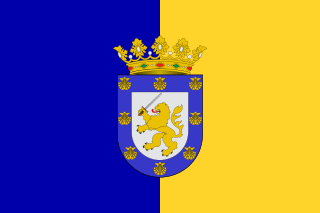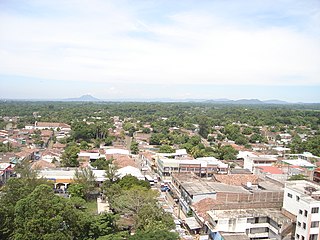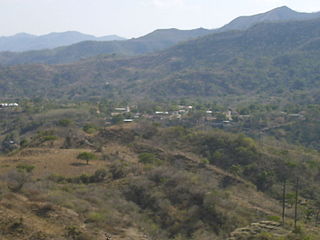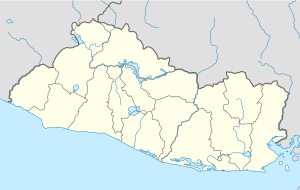
Santiago, also known as Santiago de Chile, is the capital and largest city of Chile as well as one of the largest cities in the Americas. Santiago is the center of Chile's most densely populated region, the Santiago Metropolitan Region, whose population of 8 million represents nearly 40% of the nation's total population. The city is entirely in the country's central valley. Most of the city lies between 500–650 m (1,640–2,133 ft) above mean sea level.

Guantánamo is a municipality and city in southeast Cuba and capital of Guantánamo Province.
The Nahua people, also academically referred to as Pipil, are an indigenous group of Mesoamerican people inhabiting the western and central areas of present-day El Salvador. Although very few speakers are now left, they speak the Nawat language, which belongs to the Nahuan language branch. Indigenous accounts recorded by Spanish chronicler Gonzalo Francisco de Oviedo suggest that the Nahuas of El Salvador migrated from present-day Mexico to their current locations beginning around the 8th century A.D. As they settled in the area, they founded the city-state of Kuskatan, which was already home to various groups including the Lenca, Xinca, Ch'orti', and Poqomam.

La Paz is a department of El Salvador in the south central area of the country. The capital is Zacatecoluca. La Paz has an area of 1,228 km2 and a population of more than 328,000. The department was created in 1852. There are various caves containing rock writing. The department has a church in Zacatecoluca where the Independence Hero Dr Jose Simeon Cañas y Villacorta was born. He was known as "The Liberator of the Slaves in Central America". In 1833, Anastasio Aquino, an indigenous person, proclaimed himself as "The Emperor of the Nonualcos".

The culture of El Salvador is a Central American culture nation influenced by the clash of ancient Mesoamerica and medieval Iberian Peninsula. Salvadoran culture is influenced by Native American culture as well as Latin American culture. Mestizo culture and the Catholic Church dominates the country. Although the Romance language, Castilian Spanish, is the official and dominant language spoken in El Salvador, Salvadoran Spanish which is part of Central American Spanish has influences of Native American languages of El Salvador such as Lencan languages, Cacaopera language, Mayan languages and Pipil language, which are still spoken in some regions of El Salvador.

La Virtud is a municipality in the Honduran department of Lempira.
Berlín is a municipality in the Usulután department of El Salvador.
Estanzuelas is a municipality in the Usulután department of El Salvador.

Izalco is a municipality in the Sonsonate department of El Salvador. Volcan Izalco is an icon of the country of El Salvador, a very young Volcano on the flank of Santa Ana volcano. From when it was born in 1770 until 1966, it was in almost continuous eruption and was known as the "lighthouse of the Pacific." Since then it has been nearly inactive.
Tepetitán is a municipality in the San Vicente department of El Salvador.
San Salvador Atenco is the municipal seat of Atenco, in the Mexican state of Mexico. The name "Atenco" comes from a Nahuatl phrase meaning "place on the edge of water".

Metepec is a municipality in the State of Mexico in Mexico and is located directly to the east of the state capital, Toluca, at an altitude of 2,635 metres (8,645 ft) above sea level. The center of Mexico City lies some 50 km further to the east. The city of Metepec also form part of the Greater Toluca. The name Metepec comes from Náhuatl meaning hill of the agave plants. However, it is also known in the Matlatzinca language as "Nepinta-Tuhi" meaning 'people of corn land' and in the Otomi language as "Ntaguada".

The Indios de Mayagüez are a baseball team in Puerto Rico's Liga de Béisbol Profesional Roberto Clemente. Based in Mayagüez, the Indios have won 19 national championships and two Caribbean World Series. It is one of four teams remaining from the original six incorporated into the LBPPR at its founding in 1938.

Texcoco de Mora is a city located in the State of Mexico, 25 km northeast of Mexico City. Texcoco de Mora is the municipal seat of the municipality of Texcoco. In the pre-Hispanic era, this was a major Aztec city on the shores of Lake Texcoco. After the Conquest, the city was initially the second most important after Mexico City, but its importance faded over time, becoming more rural in character. Over the colonial and post-independence periods, most of Lake Texcoco was drained and the city is no longer on the shore and much of the municipality is on lakebed. Numerous Aztec archeological finds have been discovered here, including the 125 tonne stone statue of Tlaloc, which was found near San Miguel Coatlinchán and now resides at the Museum of Anthropology in Mexico City.

Mariano Prado Baca was a Central American lawyer and a four-time, liberal chief of state of El Salvador, while it was a state in the Federal Republic of Central America.

Anastasio Aquino's Rebellion was an uprising led by Salvadoran indigenous leader Anastasio Aquino in El Salvador during the time it belonged to the Federal Republic of Central America.

Colonel Joaquín de San Martín y Ulloa was a Salvadoran military officer and politician who was twice chief of state of the State of El Salvador, within the Federal Republic of Central America.

Salvadorans, also known as Salvadorians, are citizens of El Salvador, a country in Central America. Most Salvadorans live in El Salvador, although there is also a significant Salvadoran diaspora, particularly in the United States, with smaller communities in other countries around the world.

Tourism accounts for a large part of El Salvador's economy. El Salvador has many natural attractions including beaches with some of the best surfing breaks on the Pacific Coast. El Salvador offers many lush forests shrouded in cool temperatures with abundant wildlife and scenic mountain-top vistas. El Salvador also has great potential in the field of cultural tourism; with over 2,000 known archaeological sites, mostly of the Maya and Olmec cultures. These sites are of international interest for their easy access and well preserved remains.

The Spanish conquest of El Salvador was the campaign undertaken by the Spanish conquistadores against the Late Postclassic Mesoamerican polities in the territory that is now incorporated into the modern Central American country of El Salvador. El Salvador is the smallest country in Central America, and is dominated by two mountain ranges running east–west. Its climate is tropical, and the year is divided into wet and dry seasons. Before the conquest the country formed a part of the Mesoamerican cultural region, and was inhabited by a number of indigenous peoples, including the Pipil, the Lenca, the Xinca, and Maya. Native weaponry consisted of spears, bows and arrows, and wooden swords with inset stone blades; they wore padded cotton armour.
















